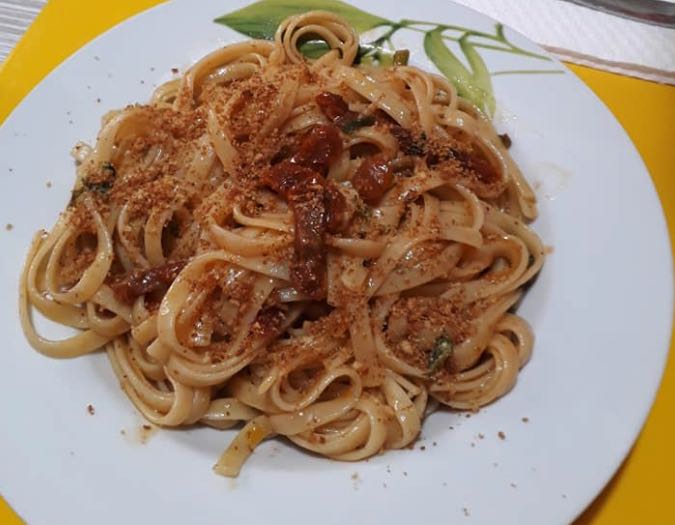Today, we’ll talk about the grape harvest and the ancient Sicilian traditions tied to it, like this exquisite pasta dâ virigna.
The viticulture is deeply rooted in the island’s millennia-old history and represents one of Europe’s oldest winemaking traditions.
Sicily’s geographic location, Mediterranean climate, and fertile soil have created an ideal environment for cultivating vines and producing high-quality wines.
The grape harvest (virigna or vinnigna in Sicilian language), the moment of grape collection, has long been one of the most significant events in Sicilian rural life.
Traditionally, it begins in late summer and continues into early autumn.
It’s a period of great excitement and intense activity in Sicilian countryside, often involving entire families and communities.
In the past, farmers would arrive at the rural estates with their families and settle there for the duration of the harvest.
The estate was where the “palmenti,” the grape pressing and winemaking rooms, were located.
The day began early, even before dawn, when men and women headed to the fields to gather grapes.
By mid-afternoon, the women would return to the estate and start preparing the evening meal.
Dinner was consumed together, gathered around long tables, savoring authentic, seasonal foods.
This flavorful pasta dâ virigna belongs to this bygone tradition, and we invite you to enjoy this recipe in the company of your loved ones, evoking the festive atmosphere of Sicilian grape harvests.
Yields and Prep Times
- Serves: 4 people
- Prep Time: 20 minutes
- Cook Time: 10 minutes
- Total Time: 30 minutes
Nutritional values per serving of “pasta dâ virigna”:
- Calories: 400-450 Kcal
- Fat: 20-25 g
- Carbohydrates: 45-50 g
- Proteins: 10-12 g
- Fiber: 3-4 g
- Sugars: 2-3 g
- Sodium: 500-600 mg
Ingredients
- 320 g of pasta of your choice
- 100 g of sun-dried tomatoes
- 1 clove of garlic
- Red pepper flakes
- Anchovies in oil
- Toasted breadcrumbs
- Grated aged caciocavallo cheese
- Extra virgin olive oil
- Salt
Directions
- Preparation of the ingredients: Start by preparing all the ingredients. Slice the garlic thinly, chop the sun-dried tomatoes (previously soaked for 10 minutes in hot water, and make sure to squeeze out all excess water), and rinse the anchovies under running water to remove excess oil.
- Cook the pasta: Bring a pot of salted water to a boil and cook the pasta according to the package instructions. Ensure it is cooked al dente, as it will finish cooking in the pan.
- Preparing the sauce: In a large skillet, heat plenty of extra virgin olive oil over medium heat. Add the sliced garlic and red pepper flakes to infuse the oil with flavor. When the garlic begins to lightly brown, remove it from the pan.
- Creating the “capuliato“: Add the anchovies to the skillet with the aromatic oil. The anchovies will melt and become part of the flavorful sauce. Also, add the chopped sun-dried tomatoes. This mixture, called “capuliato” in Sicilian, will be the savory base of your dish.
- Finish cooking the pasta: Once the pasta is almost al dente, transfer it directly to the skillet with the sauce. Continue cooking over medium heat, ensuring it blends well with the sauce. Add some pasta cooking water to help create a creamy texture.
- Add the toasted breadcrumbs (“muḍḍica atturrata“): One of the distinctive features of this pasta is the toasted breadcrumbs, known as “muḍḍica atturrata“. Toast the breadcrumbs in a pan with extra virgin olive oil until they become crispy and golden. Add the previously prepared toasted breadcrumbs to the pasta and mix well to add a crunchy element to the dish.
- Caciocavallo cheese: Serve the pasta dâ virigna with a generous sprinkle of grated caciocavallo cheese (or another aged cheese of your choice, such as a good Sicilian pecorino, for example). The cheese adds depth and creaminess to the dish.
- Presentation on the table: Serve your pasta dâ virigna on individual plates, garnishing with some additional toasted breadcrumbs and cheese.
Wine Pairing

If you want to enhance the pleasure of your pasta dâ virigna, we recommend pairing it with a glass of Contea di Sclafani Grillo sparkling wine.
This wine comes in various shades of yellow, but it’s its refined aroma that makes it an ideal companion for this recipe.
Its sophisticated scent complements the intense flavors of the sauce made with sun-dried tomatoes and anchovies, while its structured and dry taste creates a pleasant balance, enhancing the crunchiness of the toasted breadcrumbs.
To fully appreciate this pairing, make sure to serve Contea di Sclafani Grillo at a temperature between 6°C and 8°C (45°F), allowing it to reveal all its nuances on the palate.
How to store pasta dâ virigna
- Refrigerator: Once prepared, pasta dâ virigna can be stored in the refrigerator in an airtight container for up to two days. Be sure to cover it with plastic wrap or a lid to prevent it from drying out. Before consuming, it’s advisable to gently reheat it in a pan to revive the flavors.
- Toasted breadcrumbs (“muḍḍica atturrata“): The toasted breadcrumbs, known as “muḍḍica atturrata“, can be prepared in advance and stored in an airtight container at room temperature for up to one week. Ensure it is completely cooled before storing. Avoid refrigerating it as moisture can compromise its crunchiness.
Your culinary adventure with Ricette di Sicilia: Pasta dâ virigna
In conclusion, pasta dâ virigna is a dish that combines authentic flavors and Sicilian culinary tradition into a tasty and memorable experience.
Its simple yet rich preparation tells the story of past grape harvests in the Sicilian countryside and families coming together to share a genuine meal.
With its flavorful sauce, enriched by the crunchy “muḍḍica atturrata” and grated caciocavallo cheese, this pasta embodies the warmth and hospitality of the island.
If you enjoyed this recipe, don’t forget to share it on your social channels and leave a comment below!

